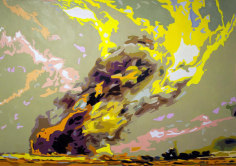
Blast
Oil, alkyd on canvas
62 x 90 inches
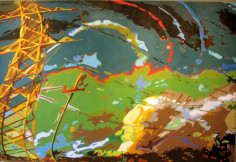
Prelude
Oil, alkyd on canvas
65 x 96 inches
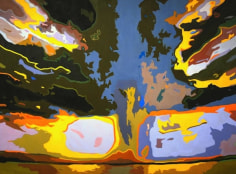
Cataclysm
Oil, alkyd on canvas
66 x 91
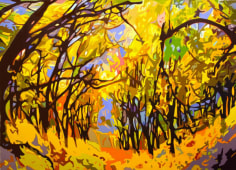
Mingora
Oil, alkyd on canvas
68 x 96 inches

Firestorm
Oil, alkyd on canvas
36 x 96 inches
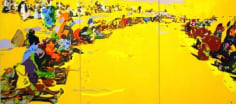
Darfur / Sudan
Oil on wood (3 panels)
40 x 90 inches
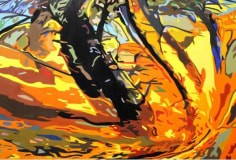
Uprooted
Oil, alkyd on wood panels (2)
48 x 72 inches
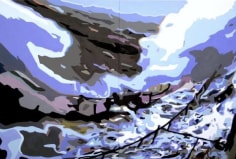
Union Beach
Oil on wood
48 x 72 inches
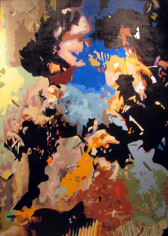
The Day The World Stood Still I
Oil, alkyd on canvas
97 x 67 inches
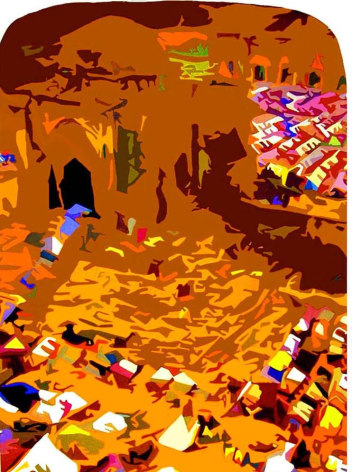
Tents
Oil on canvas
74 x 56 inches
Afganistan Bridge
Oil on canvas
54 x 84 inches
Burning Tank
Oil on canvas
84 x 54 inches
Captured
Oil on canvas
60 x 90 inches
Refugees
Oil on canvas
64 x 96
MidEast Ruins
Oil on canvas
90 x 60 inches
Carl Hammer on Grace Graupe - Pillard:
In Blast Wave, the artist skillfully combines elements of both beauty and horror into her paintings. Images that have been scavenged out of newsprint photos are transformed into large scale, frighteningly powerful, minimally recognizable abstractions of forces both terrible and glorious in their beholding. When closely approaching the work, Graupe Pillard’s paintings seductively combine color, shapes and forms, bringing all elements together as a camouflage or a jigsaw puzzle abstraction. Yet, stepping away, with all the pixels falling into place, we focus, instead, on a tragic and terrible scene of power out of control, destructively threatening, yet so beautiful. There is a perception of evil here, a personification combined with the artist’s painterly adroitness, equating to one’s encounter of a raging fire devouring a building or an immense stand of trees. At the same time while recognizing its devastation, one cannot avoid admitting to its beauty.
Early life and career
Grace Graupe was born in Washington Heights, NYC, the daughter of Else Graupe, a Dressmaker/Designer and Gerhard Graupe, an Architect who was lead architect for Herman Jessor and Co. building middle-income housing in NYC such as Penn South, Co-op City, Van Cortlandt Park /Amalgamated, Rochdale Village, Seward Park Housing, etc. Both greatly influenced her work. She was also influenced by individuality, or a lack there of, due to having a twin sister Florence and believed people should look past appearances. She attended the High School of Music and Art and the City College of New York where she earned her Bachelor's degree in history and political science. She briefly went on to CUNY Graduate School in Russian Area Studies which she abandoned to go back to art school studying drawing with Marshal Glasier at the Art Students League in Manhattan where she received a George Bridgman Scholarship juried by Philip Guston.
Artworks
Graupe-Pillard is a painter, public artist, educator and makes videos, having exhibited artwork in many venues including Carl Hammer Gallery, Chicago, The Proposition, NYC, Hal Bromm Gallery, NYC, Rupert Ravens Contemporary and Aljira-A Center For Contemporary Art in Newark, NJ, etc. She has participated in group exhibitions at The Noyes Museum, P.S. 1, Bass Museum, Indianapolis Museum, The Maier Museum, The Aldrich Museum, The Drawing Center, The Hunterdon Museum, The Frist Center, and The National Academy Museum. Her photos and videos have been presented at Lars von Trier’s Gesamt, Warsaw Jewish Film Festival, Scope Miami, Scope London, Art Chicago, Art Fem. TV, Cologne OFF, Found Footage & SHOAH, etc.
Early works
Upon returning to New Jersey in 1974 after living in New Mexico for six years where she met and married Stephen Pillard, she joined the feminist movement and began painting men and women who were not typically seen as "attractive," and not fitting into the art historical canon of the "nude," i.e.: focusing on women with stretch marks. Throughout the 70’s, 80’s and 90’s Grace Graupe-Pillard drew nude figures not of models but of neighbors, friends, and other everyday people. Her subjects were often middle-aged with middle-aged physiques, and her renditions of them were not primarily meant to be sensual or sexually appealing. Graupe-Pillard said, “My work since 1975 has dealt with feminist issues beginning with paintings of large frontal nudes of men and women of various ages who did not “fit into” the dictates of the “gaze” of the male-dominated art history/museum network”.
From 1984 to 1994 Graupe-Pillard worked with a traditional medium in a non-traditional way creating large pastel/cutout-canvas installations. She found that pastels, which have often been thought of as a woman’s tool to be used for woman’s “delicate” subjects, was the perfect medium for her to document the often difficult “art of survival” in NYC. She also found that there was an immediacy and directness to using pastels that mimics the speed and excitement of the urban environment with its contradictory elements of squalor and glamour. Graupe-Pillard worked on large pastel drawings of everyday people, including break dancers, pedestrians, and the homeless, to make them appear mythic and heroic. Graupe-Pillard also used these portraits to comment on social issues such as mortality, as seen in the piece Balance/Woman (1989), where the elderly are slowly decaying as younger generations defy the pull of the world. According to Graupe-Pillard, “Power and the abuse of power- such as the conflicts between men and women both on a personal and political level- are ever-present in my consciousness and my artwork.” Contemporary life was chronicled through the creation of large cut-out pieces which were installed on one or more walls. The individuals portrayed in these murals feature diverse juxtapositions of age, sex, class, race, and vocation to produce a “human theater of types, gestures and emotions”. (Michael Brenson, NY Times 3/29/85.) Graupe-Pillard said that she wished to make those people that are quite often “invisible” permanently “visible”. Architectural elements, and fragmented images of American life and culture were also included. Shifts in place and scale, different rhythms, and a richness of color and form produced a sense of the surroundings. The synthesis of figures, portraits, and silhouettes made a statement of how private thoughts and public postures interplay in the metropolis. In the early 1990s she worked on her Silhouette Series employing a wider range of imagery, using silhouettes to serve as a contour framing device for more personal and poetic concepts.
War series
From 1990 to 1993 Graupe-Pillard created Nowhere To Go - One Family's Experience that dealt with the destructive effects of power in a series which was exhibited at The NJ State Museum and at Rider University, NJ entitled: The Holocaust: Massacre of Innocents. This series consists of large canvases that depict figures of Jewish prisoners that reflect on the experience of her father and paternal grandparents during the Holocaust in Nazi Germany and is a recurring theme in her work. She grew up with the knowledge of her father’s pain, which resulted from his inability to save seventy family members during the war. She uses symbolism to comment on the events: rabbits for the medical experimentation, mass genocide, and sweeping speed with which the war grew. She also drew the figures to reflect the propaganda of anti-Semitism during the Holocaust, with hooked noses and pickpocketing hands. Also found in her work are images of gas masks, chain link fences, swastikas, and photos of her grandparents who died there. Graupe-Pillard chose the softness of pastels to create this series, and noted that it was not a medium generally used to depict the harshness of war. Despite her multiple war series, Graupe-Pillard has remarked, “I don’t think art can make a difference. Otto Dix painted the disasters of war, but very few people know of him or have seen his paintings because he’s not a rock star or a media star.”
Another series entitled MANIPULATION/DISPLACED PAINTINGS 2002–2015 was influenced by 9-11 and the onset of the Iraq war. In a world where terrorism, ethnic cleansing, and cultural upheaval have dominated the news headlines, these paintings focus on the devastating effect of war and its impact on the civilian population. Entitled DISPLACED, this series correlates the displacement of civilians in war-torn countries with a visual disintegration of form, evident in both the creative process and in the final painted product. In each painting, the chaos of cultural disintegration is symbolized by the fragmentation of the picture plane. With repeated editing and” filtering” in computer programs reiterating the filtering of information, she appropriates images from journalistic sources, “blowing apart the reality” of the photograph so that the final result is distilled and disintegrated from its original context, and reduced into unpredictably flatly colored eccentric shapes further emphasizing the fragmentation of form and removal from its original source.
Graupe-Pillard’s archival pigment print war series Interventions began in 2003 and focused on overseas wars. Interventions was a union of her mediums of choice, photography and painting, and an advanced use of color manipulation. The collages show a decline of cultural sanctity and suffering due to war. To create Interventions, she used high resolution photos of familiar locations in major cities, including New York, Baltimore, Newark, and Chicago, and digitally overlaid them with collaged depictions of war, such as car bombings, destroyed buildings, refugees, and soldiers. She used this combination to provoke the idea of war in ones’ own backyard for viewers.





